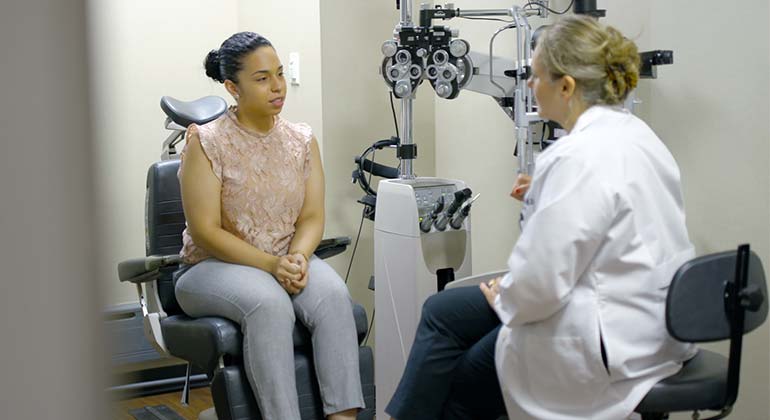Personalized Cataract Care Service: See Our Clinic for Solutions
Personalized Cataract Care Service: See Our Clinic for Solutions
Blog Article
Exploring the State-of-the-Art Technologies Utilized for Dealing With and detecting Eye Problems
In the realm of ophthalmology, the advancement of modern technology has considerably boosted the devices available for detecting and treating different eye conditions. From advanced imaging technologies that provide detailed insights into eye frameworks to robotic-assisted procedures that offer unrivaled precision, the landscape of eye care is continuously evolving. With the combination of artificial intelligence in diagnostics, genetics treatment advancements, and virtual reality rehabilitation, the opportunities for improving person results are increasing at a fast speed. The convergence of these sophisticated technologies holds the promise of transforming the field of ophthalmology, offering brand-new avenues for customized and efficient treatments.

Advanced Imaging Technologies
Advanced Imaging Technologies have changed the area of ophthalmology by supplying in-depth and precise visualization of the eye frameworks. Optical Coherence Tomography (OCT) stands out as a vital technology in this realm. OCT uses light waves to catch high-resolution cross-sectional pictures of the retina, enabling the recognition of minute structural adjustments. This non-invasive technique help in the early discovery and surveillance of numerous eye conditions such as macular degeneration, diabetic retinopathy, and glaucoma.
In Addition, Fundus Photography is an additional essential device in ocular imaging. This technique involves recording thorough pictures of the back of the eye, consisting of the retina and optic disc. Fundus Digital photography aids in documenting the progression of eye illness, assessing treatment effectiveness, and informing clients regarding their eye health and wellness.

Robotic-Assisted Surgery
Robotic-assisted medical procedures have significantly advanced the capabilities of ophthalmic surgery, ushering in a brand-new age of accuracy and performance in treating different eye problems. By incorporating robotic modern technology into procedures, ophthalmologists can accomplish unrivaled accuracy and control, resulting in improved individual outcomes.
Among the key advantages of robotic-assisted surgery in ophthalmology is the enhanced mastery and security it provides to specialists. The robotic arms can carry out accurate motions with a high degree of precision, enabling fragile treatments with minimal invasiveness. This level of accuracy is specifically beneficial in surgical treatments entailing the retina, where even minor mistakes can have substantial effects for an individual's vision.
Additionally, robotic-assisted surgical systems offer real-time imaging and responses to the specialist, allowing them to make informed choices throughout the treatment. This technology improves the specialist's situational awareness and permits modifications to be made quickly, guaranteeing optimal outcomes for the client.
Expert System in Diagnostics
With the advancement of innovative modern technologies boosting medical precision in sensory procedures, the assimilation of Artificial Knowledge in diagnostics has emerged as a critical advancement reinventing the field of eye care. Expert System (AI) formulas are being significantly used to examine complex data from imaging technologies like optical comprehensibility tomography (OCT) and fundus photography to help in the early discovery and accurate diagnosis of different eye conditions. These AI systems can effectively recognize patterns and abnormalities in images that might not be noticeable to the human eye, making it possible for quicker diagnosis and treatment preparation.
AI formulas can likewise anticipate illness progression, recommend personalized therapy strategies, and assess the effectiveness of treatments. By enhancing retina service near me the diagnostic process, AI not just boosts the effectiveness of eye care professionals however additionally enhances individual outcomes by enabling timely interventions. As AI remains to advancement, its function in diagnostics is expected to increase, offering brand-new opportunities for very early treatment and tailored treatment in the field of ophthalmology.
Gene Treatment Developments
In the world of ophthalmic advancements, recent strides in genetics therapy technologies have stimulated substantial rate of interest amongst scientists and medical care experts alike. Genetics treatment holds immense promise in reinventing the treatment of numerous eye problems by targeting the underlying hereditary reasons. By presenting hereditary material right into cells to compensate for abnormal genetics or to supply a missing gene, genetics treatment supplies a personalized method to addressing acquired eye disorders such as retinitis pigmentosa, Leber congenital amaurosis, and others that were formerly thought about untreatable.

As research in gene therapy continues to development, the possibility for tailored treatments for a larger series of eye conditions grows, using brand-new expect individuals with genetic eye conditions.
Online Fact Rehab
Online truth rehab has arised as a sophisticated approach in improving the recovery and recovery processes for people with different aesthetic disabilities. hearing service near me. By simulating real-world atmospheres via immersive innovation, virtual fact provides a distinct system for vision therapy and rehabilitation. This innovative technique allows individuals to participate in interactive exercises and activities developed to improve visual acuity, depth understanding, eye sychronisation, and general aesthetic performance
One trick advantage of virtual fact rehab is its capability to customize treatment programs based upon the certain needs and capacities of each individual. With real-time feedback and surveillance, health care experts can track progression, change interventions, and offer individualized like optimize results. In addition, digital truth modern technology can produce a risk-free and regulated room for individuals to exercise visual jobs, conquer challenges, and build self-confidence in a virtual setup prior to transitioning to real-world situations.
Conclusion
To conclude, the advancements in imaging technologies, robotic-assisted surgical treatments, expert system diagnostics, genetics therapy technologies, and digital reality rehabilitation have actually considerably boosted the diagnosis and therapy of eye problems. retina service near me. These cutting edge innovations have reinvented the area of ophthalmology, permitting more precise and efficient treatments. As innovation remains to advance, the future of eye treatment looks encouraging with the capacity for also more innovative solutions to boost individual outcomes
In the realm of ophthalmology, the advancement of technology has actually dramatically boosted the devices available for diagnosing and treating different eye conditions. Fundus Photography assists in documenting the progression of eye conditions, assessing treatment effectiveness, and enlightening patients regarding their eye wellness.
Man-made Intelligence (AI) formulas are being significantly used to examine complicated information from imaging modern technologies like optical comprehensibility tomography (OCT) and fundus photography to assist in the very early detection and accurate medical diagnosis of different eye problems.In final thought, the improvements in imaging technologies, robotic-assisted surgical procedures, fabricated intelligence diagnostics, gene therapy innovations, and online fact recovery have considerably boosted the diagnosis and treatment of eye conditions. As innovation proceeds to develop, the future of eye care looks encouraging with the possibility for also more innovative remedies to enhance client outcomes.
Report this page